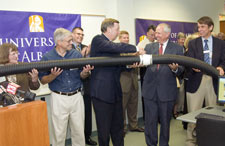Release
University at Albany
Launches College of Computing and Information
New College will enrich undergraduate
and graduate education and pose new partnerships
with industry and government
 |
|
Connecting a symbolic coaxial cable are, from left, Carol A. Doll, College of Computing and Information; Neil V. Murray, chair, Department of Computer Science; Kermit L. Hall, UAlbany president and professor of history; Peter A. Bloniarz, dean, College of Computing and Information; David F. Andersen, Department of Public Administration and Policy |
|
Contact: Catherine Herman (518) 437-4980
ALBANY, N.Y. (August 29, 2005) -- The University at Albany today announced the establishment of a new College of Computing and Information designed to prepare the information technology (IT) workforce of tomorrow, advance scientific research and to further UAlbany's partnerships with government and industry.
"We want to make sure that every University at Albany student has the IT skills to compete in life," said University at Albany President Kermit L. Hall. "The new College of Computing and Information looks to the future and addresses the need for information technology knowledge in all academic areas and further strengthens our role in Tech Valley. I commend Dean Peter Bloniarz and the faculty who worked to create the college and for the exciting opportunities it poses to partner with government and industry."
The establishment of the college comes at a time when IT is one of the fastest-growing areas of job growth, according to the U.S. Department of Labor, which projects that 70 percent of the next decade's new jobs in science and technology will be in information technology. The DOL also projects that in the next decade, IT job growth will outpace the rate at which students are graduating with IT degrees.
The new College leverages the strength of three University academic units to attract new resources that will support university-wide information science and information technology programs. These units include the departments of Information Studies (formerly the School of Information Science and Policy), Computer Science, and the Informatics faculty, the home of the University's program in information science. The College will continue to offer a master's program in information science that is accredited by the American Library Association through the Department of Information Studies, and will continue existing undergraduate and graduate degree programs in computer science and in library and information science.
In 2004, the University created "IT Commons," which served as a launching point for the College of Computing and Information. This initiative provides critical information technology skills to students across disciplines. Now offering more than 225 courses that incorporate information technology, the College concentrates on focused programs in computer science and library and information sciences.
Dean Peter A. Bloniarz said, "The U.S. Department of Commerce says that nearly three quarters of the jobs in the Northeast are information-intensive, and this figure continues to grow. As head of the new College of Computing and Information, I am excited by the possibilities for global research, collaboration, learning, and growth that our focus will bring. I'm particularly looking forward to enhanced partnerships with government and industry to create a rich learning environment for our students. By turning out an educated workforce empowered with strong computing and information capabilities, UAlbany is well-positioned to ensure that our graduates are active contributors to, and informed citizens of, today's information-based economy."
The College concentrates on focused programs in computer science and library and information sciences. It also creates teaching and research partnerships with other UAlbany schools and colleges including the School of Business, College of Nanoscale Science and Engineering, Center for Functional Genomics, School of Education, Center for Technology in Government, and other interdisciplinary programs in information technology that take advantage of faculty who incorporate information technology in their research and teaching.
James T. Dillon, New York State Chief Information Officer, said, "I commend the leaders of the University at Albany for establishing the College of Computing and Information. The workforce of tomorrow must be agile, highly skilled and well trained to adapt to the dynamic conditions of today's technology-driven economy. Graduates from this college will bring cutting-edge technology skills to our state's workforce that will benefit businesses and government alike."
Alain E. Kaloyeros, Vice President and Chief Administrative Officer of the College of Nanoscale Science and Engineering, said, "With the explosive growth in global educational, research, and business opportunities in information technologies, the College of Computing and Information is strategically positioned to play a critical role in advancing leading edge scientific discoveries and educating future generations of workers. The college will provide an integrated package of resources and capabilities, including the brainpower and creativity, necessary to ensure cutting-edge innovations and successful commercialization. I congratulate President Hall and Dean Bloniarz and look forward to establishing inter-disciplinary and synergistic collaborations between our two colleges."
Plans for the College include internships, consulting opportunities, formation of an external advisory board, and university-industry alliances. The College will bring together students and faculty concerned with user enterprises, applying technology, technology design and development, testing, verification, and scientific analysis.
For more information on the college,
visit www.albany.edu/cci.
